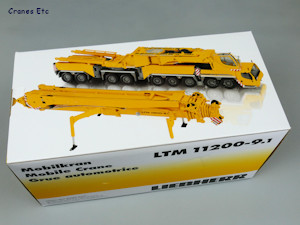 | | Liebherr-style box. |  | 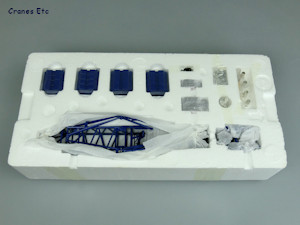 | | The middle tray has the counterweights, boom head sections and hooks. | 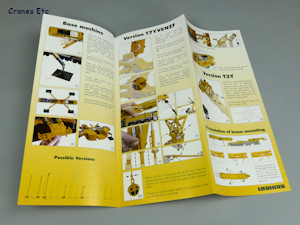 | | The instruction sheet. | 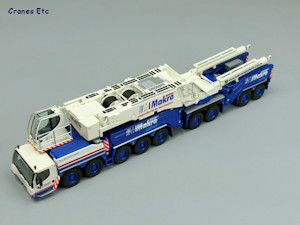 | | Posed in road-going configuration. | 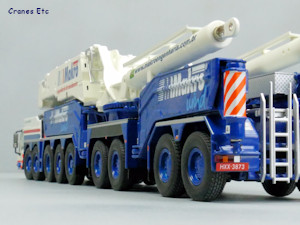 | | Realistic look. | 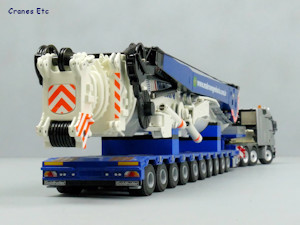 | | Boom being transported on a carrier. | 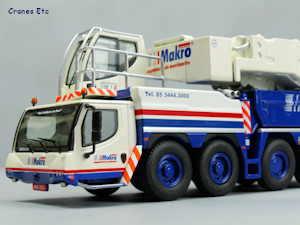 | | Michelin branded tyres. | 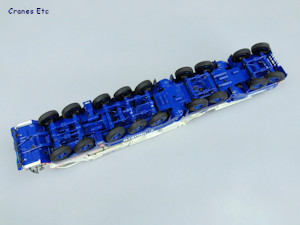 | | Detailed chassis. | 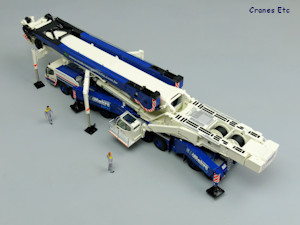 | | The carrier can drive under the boom so it can be attached. | 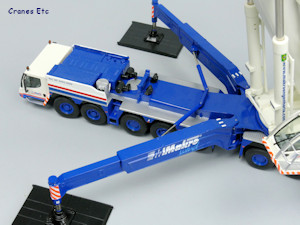 | | Heavy outriggers. | 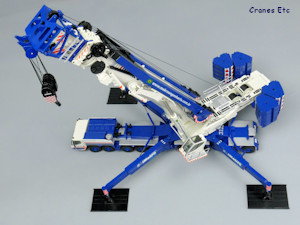 | | Heavy lift head fitted and heavy hook reeved. | 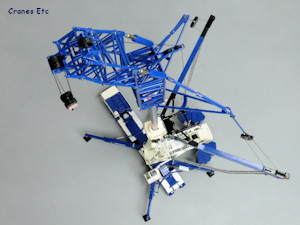 | | Rigged with the lattice jib and Y-Guy arrangement. | 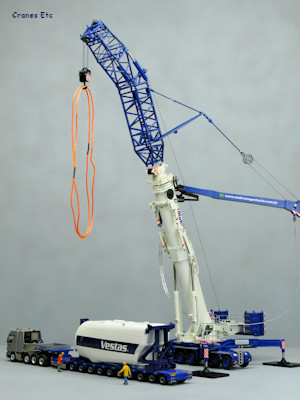 | | Getting ready to lift a turbine nacelle. |
|  Comment on this model. Comment on this model.
The Liebherr LTM 11200-9.1 first appeared at the BAUMA exhibition in 2007. It travels on a nine axle carrier and the weight of the boom is such that it has to be transported on a separate vehicle. The dimensions of the real crane are huge with the carrier almost 20m long, and the boom weighs around 100t and is also nearly 20m long. As the name suggests the crane is rated at 1200 tonnes lifting capacity, albeit at 2.5m radius. Lifting height on the telescopic boom is nearly 100m, and a variety of fly jib combinations can increase the overall lifting height to 188m.
This version of the model is in the colours of Makro Engenharia, a Brazilian crane services company.
Packaging
The model comes in a fairly large Liebherr-styled box which is heavy, and the model is securely contained within three expanded polystyrene trays. It is very protected well in the box with many parts wrapped in soft paper.
There were no defects or missing parts on the review model.
A large coloured instruction sheet is provided, and this is in German and English. This describes how the various configurations of the crane can be built, and is of good quality. A parts list is missing which describes the various bolt types, but NZG have subsequently produced one and it can be downloaded here.
Assembly of the model is not difficult, and the model engineering is very good so it goes together well. Some of the nuts and bolts are absolutely tiny however, and will be easily lost if they fall on the floor. NZG have thoughtfully provided some spares with the model.
No information is provided about the real machine.
Detail
The carrier is heavy, and turning it over carefully reveals an excellent level of detail. The main drive train is provided to the four driven axles, and the suspension is modelled and there are various tanks and other features. The wheels have excellent Michelin-branded tyres and these are mounted on varying hub designs depending on the axle.
The outrigger beams are metal and very solid, with very good details within the casting. The rear outriggers have a storage box and bracket attached. The outrigger pistons are smooth and look realistic, with metal pads which are pin-connected on the bottom. Heavy metal spreader plates provide a solid footing and it is nice to see these included with a crane model.
At the front, the driving cab has all of the usual detailing that would be expected including a realistic number plate, and interior details are fine too. The cab windows are lightly tinted and have black edging representing window seals. Behind the cab, there is a very pleasant exhaust arrangement and other equipment. A fine diamond textured surface covers most of the carrier, and at the rear there is a good access ladder, and the beacon lights and light arrays are very convincing.
The crane body sits on a large toothed slewing ring and a slewing motor is modelled on each side of the body. The operator's cab is nicely formed with a mesh walkway and handrails on the outside, and there are some very finely made windscreen wipers.
The body has some detail within the casting and this includes walking surfaces on the top deck. A pair of access ladders, handrails and an exhaust pipe have to be fitted as separate parts and some care is needed with the handrails when lifting the boom to make sure that they are not inadvertently crushed.
At the rear the heavy counterweight tray is screwed in, and the counterweights interlock as they are placed. Each piece of counterweight is well formed with good graphics and with care can be posed being lifted by a support crane. The only variation with the real crane is that the model has 16 10t weights and misses out four 5t weights.
The main boom lift cylinders have plastic jackets complete with pinning holes so a boom elevation can be maintained. The colour match of the plastic parts is good but metal parts would have been in keeping with the rest of the model.
In terms of detail the absence of hydraulic lines to cylinders and motors produces a clean if less detailed model. The thread used on the two winch drums is good quality.
The boom is a hugely impressive piece and is very heavy as it has eight telescope sections. The lowest section has the boom mounting outriggers modelled and these are all metal parts, and include metal pads and again the pistons are smooth and look authentic. A few cable spools are also mounted on the boom.
The telescope sections are engineered very well and they have very realistic looking collars at the top of each section. At the boom head there are excellent black metal pulleys which are perfectly free rolling.
The Y-Guy arrangement is robustly modelled with good details at the winches where bolt heads are modelled within the casting. The connections from the Y-Guy to the bottom of the boom are modelled in a pliable metal material which is great because it can be set to hang realistically in a catenary shape and is so much better than a plastic part. Perhaps the only missing item in relation to the boom assembly is a separate power pack cart used to drive the boom mounting cylinders.
Two boom attachments are supplied. A short heavy lift head is fixed directly to the fourth telescope section and is modelled very solidly and includes a ladder and also roller discs for being rolled along the ground.
The lattice mast jib is a bigger assembly comprising heavy lattice work which is well formed. Pleasingly, the whole assembly is made of five different pieces which bolt together so it is possible to split it down into separate parts.
Three hooks are supplied. One is a single line block and the others have 3 and 11 pulleys respectively. They are very nicely made and detailed pieces with the two larger blocks having a swiveling hook.
Features
Each axle on the carrier can be independently steered to a good angle and so any of the steering modes of the real crane can be reproduced. They also have working suspension which provides a good range of movement on each wheel.
The outriggers fold out and extend telescopically, and the pistons screw down to engage the pads which are pinned on. The arrangement is sufficiently strong to support the whole model and it can be lifted off its tyres.
The boom mounting legs rotate out from their stored position and can be extended to support the weight of the boom. However the pistons are on the limit of their travel in order to get the carrier to drive underneath the supported boom without fouling.
It is possible to show the crane alternatively being transported without the inner four telescope sections, and this is achieved by pushing in the locking clip and continuing to pull out the telescope The only care needed is not to lose the spring and locking clip which tend to pop out when the telescope finally emerges.
Raising the boom is straightforward and the main lift cylinders are fairly stiff, but not stiff enough to hold such a heavy boom at an angle. The cylinder jackets have holes for pins which can be used to lock the boom at a steep angle.
The Y-Guy arrangement opens up fully for use, and each of the spools for the ropes connected to the jib head have spring-loaded brakes so a good tension can be set if desired.
The lattice mast jib can be adjusted for angle using the hydraulic cylinders which are very stiff and will not bleed down.
The model rotates well and the two winches are spring loaded so they can hold a good load on the hook. The winches are accessed through holes in the body on the left side. The forward winch can be operated without removing ballast and the rear one requires a stack of ballast to be removed.
The operator's cab is on a flexible linkage like the real crane so it can be folded for transport, or lowered to the ground to provide access to the cab without a ladder. The cab also tilts for operator comfort during lifts at height.
A great feature of the model is that it can be set up in five different configurations by mixing the jibs and use of the Y-Guy arrangement. These, coupled with the various transport possibilities give an excellent variety of posing possibilities.
Quality
This is another high quality version of the LTM 11200, with a very high metal content.
The paintwork and graphics are very good.
Price
This is a large and expensive model but it is also excellent value.
Overall
It looks very attractive in the colours of the Brazilian company Makro. The model engineering is of an excellent standard as is the detailing.
The LTM 11200 is one of the best heavy crane models made.
Footnotes
The model first appeared in December 2009 after being shown as a prototype at the Nuremberg Toy Fair in February 2009.
Many different coloured versions have been produced. This version in Makro colours was announced at the 2015 Nuremberg Toy Fair and it was released in November 2015 in a run of 100 models.
|
| |
| 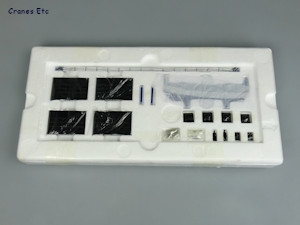 | | The top tray includes the outrigger spreader plates and counterweight tray. | 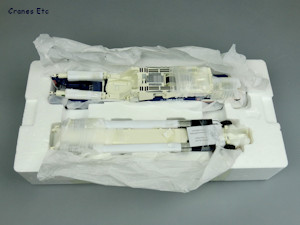 | | The bottom tray has the carrier and the boom. | 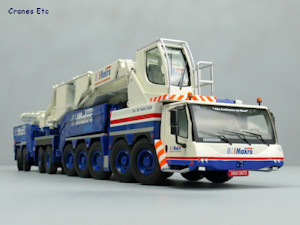 | | All axles steer. | 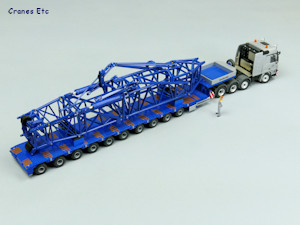 | | Lattice boom is a good load. | 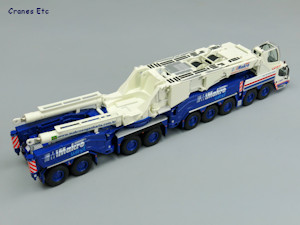 | | Impressive carrier. | 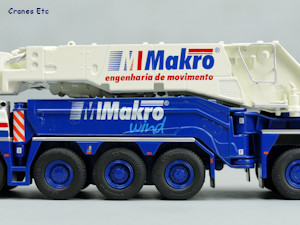 | | Excellent graphics. | 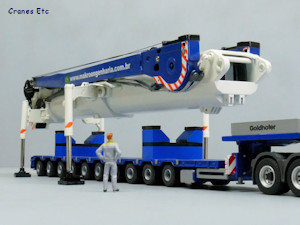 | | Boom lifting itself off the carrier. | 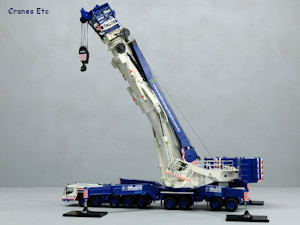 | | Ready to lift. | 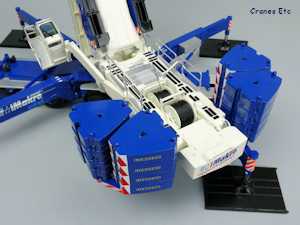 | | Impressive counterweight. | 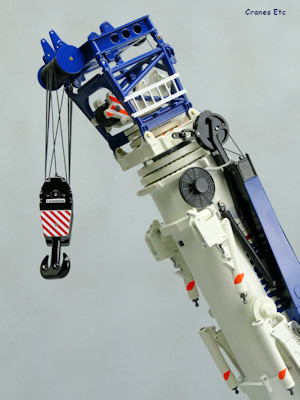 | | Detailed heavy lift head. | |
| 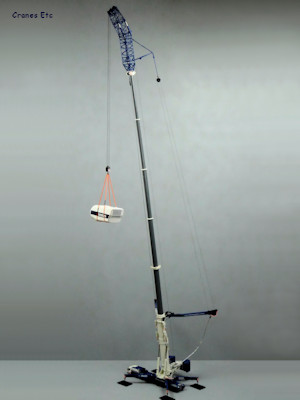 | | Open up the telescopic boom and a massive model nearly 2.5m high results. Here the crane has two sections unextended.. |
|

